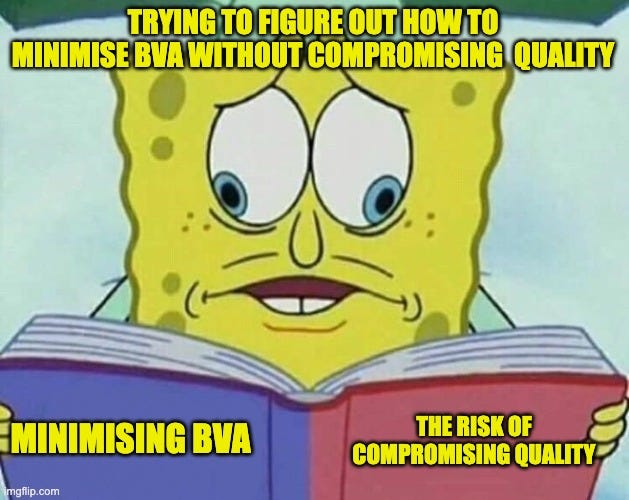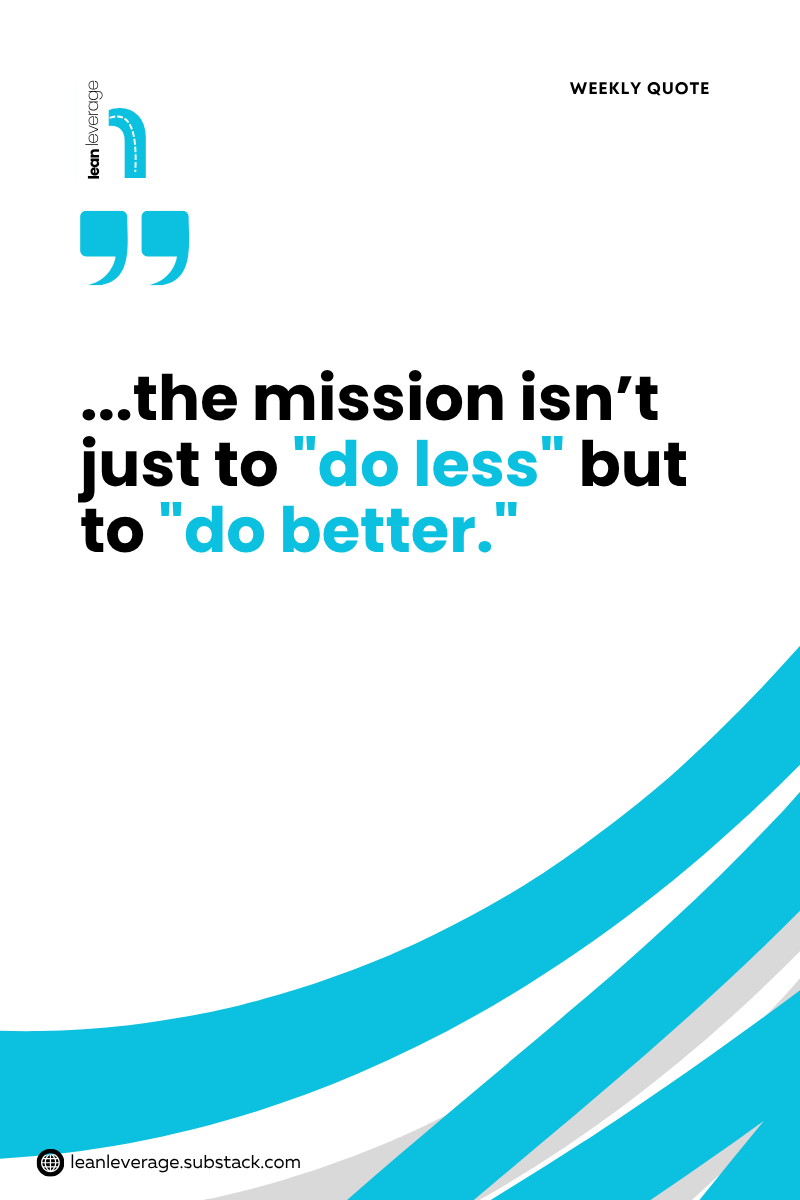Do We Risk Quality When We Minimise Business Value-Add?
Minimising Business Value-Add should always be strategic. The idea is to protect the outcomes that matter while trimming the unnecessary fluff.
Hello friends,
A few weeks ago, my colleague and I were facilitating a Lean training session, explaining the good old concept of value and waste. You know the drill: in Lean, we aim to maximise Value-Add (VA), minimise Business Value-Add (BVA) (some call it Non-Value Add Essential), and eliminate Non-Value Add (NVA) waste.
In the middle of our usual passionate breakdown, one of the participants raised his hand and asked a question that nearly made me shout, "Not today please!":
"Are there no risks associated with minimising Business Value-Add? Couldn’t that compromise quality?"
It was, hands down, one of the best questions I’ve heard during a training. Because the man had a point!
So today, I want to talk about it.
First things first: What is Business Value-Add (BVA)?
I’ve explained this before here, but because I like you and would go to any length to explain stuff to you, I’ll repeat myself.
BVA (also called Non-Value Add Essential) refers to the steps that don’t directly deliver value to the customer but are necessary to ensure smooth operations, legal compliance, safety, or quality. Think of inspection, documentation, or in some cases, mandatory approvals.
The goal is to minimise BVA, not eliminate it. If you eliminate necessary steps blindly, you may reduce waste but create risk and frustration, damage the customer experience or worse, get into litigation issues with your customers.
Let me give you an example to drive this home:
The Case of Mr. John and footng.com
Imagine it's 2010. Mr. John, a regular guy, wants to order a new pair of shoes from an online store called footng.com. (Yes, I ran this in Naija, we don’t have a website yet, assume we do and just stay with me.)
John finds the shoes, adds them to his cart, and then the dreaded checkout process begins.
He has to type out his full address: house number, street name, city, postcode, local government, everything. By the time he’s done, his mood has shifted from “I love these shoes” to “I’m tired, abeg.”
Worse still, he might accidentally type his address wrong. Now his shoes could end up at someone else’s house, probably in Port-Harcourt instead of Lagos, and customer service gets dragged in to fix the mess. Time wasted. Effort wasted. Happiness? Gone.
Now imagine FootNG decides to minimise Business Value-Add smartly. They introduce a postcode lookup on their e-commerce website:
John types in his postcode.
A dropdown shows his full address.
He picks it, clicks pay, and boom done.
Same quality; actually better, because of fewer mistakes, faster process, happier customer.
That’s what minimising Business Value-Add without compromising quality looks like.
Nobody removed the need for an address (that’s still essential).
They just made the delivery of that information smoother, quicker, and less stressful.
3 Things to Consider When Minimising BVA (Without Compromising Quality)
Work Backwards from the Desired Outcome: Don’t start with the process. Start with the result you want in mind. In FOOT-NG’s case: "We want the correct delivery address and a faster checkout process for customers." Then think: what is the least complicated way to get that result without introducing risk?
Focus on Simplicity, Not Shortcuts: When minimising BVA we are not trying to cut corners. We just want to make the process as simple and foolproof as possible, whilst getting the same outcome or better. If you can reduce time, effort, and errors in one move, do it. But if you remove something just for speed and lose accuracy, you’ve gained nothing but headache.
Test the Impact Before Rolling Out: Before you officially roll anything out, test it. Run small pilots, gather feedback, and check if quality, safety, or compliance is affected. If you’re not careful, you’ll wake up one day and realise you’ve built a faster process that delivers the wrong thing!
Final Thoughts
In Continuous Improvement, the mission isn’t just to "do less" but to "do better." Minimising Business Value-Add should always be strategic. The idea is to protect the outcomes that matter while trimming the unnecessary fluff.
So, back to the question that was raised in the training, the answer is - Yes, we can compromise quality, but ONLY if we do it blindly.
That’s it for today.
Thank you for reading,
Tomiwa Femi-Philips
Improvement Enthusiast





Love the focus here: don’t just do less, but do better! Great post! 💙